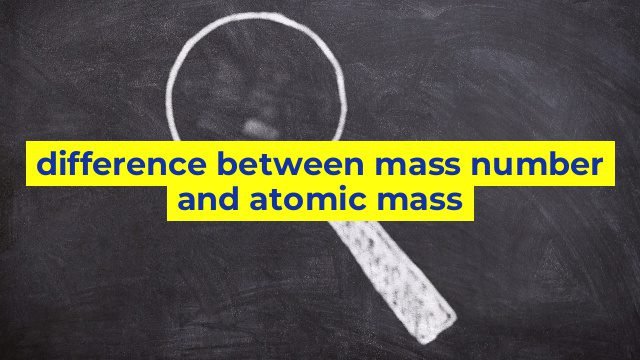Difference between Mass Number and Atomic Mass
Introduction
With the advancement in science, we have come across several interesting discoveries about the elements that make up our world. The characteristics and properties of elements are determined by the composition of subatomic particles they possess. The atoms of these elements are composed of three types of subatomic particles, namely protons, neutrons, and electrons. As a result, two measurable quantities, mass number, and atomic mass come into play. In this article, we will look at the difference between these two quantities and their relevance in the world of chemistry.
Atomic Mass
Atomic mass refers to the mass of a single atom of an element in atomic mass units (amu). An atomic mass unit is defined as one-twelfth of the mass of a carbon-12 atom. The atomic mass of an element is calculated by taking into account the average mass of all the isotopes of an element with their respective abundances. The atomic mass is an essential property that helps determine the physical and chemical properties of the element.
Mass Number
The mass number is the total number of protons and neutrons in the nucleus of an atom. It is represented by the letter A. The mass number alone cannot determine the element’s identity; it can have different isotopes that have the same atomic number but different mass numbers. As a result, the mass number is written as a superscript before the elemental symbol to indicate which isotope is being referred to.
Key Differences
The key difference between atomic mass and mass number is that atomic mass considers all the isotopes of an element, whereas mass number pertains to a particular isotope. The atomic mass is a decimal number since it is an average of all the isotopes, while mass number is always a whole number. Another significant difference is that atomic mass is a relative mass of an atom in comparison to the mass of a carbon-12 atom, while mass number is an absolute quantity that is the sum of protons and neutrons in a nucleus.
Conclusion
In conclusion, we can say that both atomic mass and mass number are crucial properties of an element. Atomic mass is an average mass of all the isotopes of the element, whereas mass number pertains to a specific isotope. The atomic mass is measured in atomic mass units, while mass number is an absolute quantity that is a sum of protons and neutrons in a nucleus. Understanding these differences is essential for those working in the field of chemistry and researchers measuring the physical and chemical properties of isotopes.
Table difference between mass number and atomic mass
| Mass Number | Atomic Mass |
|---|---|
| The number of protons and neutrons in the nucleus of an atom. | The average mass of all the isotopes of an element. |
| It is always a whole number. | It can be a decimal number. |
| It is used to calculate the number of neutrons in an atom. | It is used to compare the masses of different elements. |
| It is specific to a particular isotope of an element. | It takes into account the relative abundance of all the isotopes of an element. |

